Boeing B-17 Flying Fortress, Athenry, Galway, January 15th, 1943
Of all the survivable landings of foreign aircraft that
occurred in neutral Ireland during the Second World War, perhaps
the best known about is the landing of the American B-17 Flying
Fortress bomber commonly referred to as 'Stinky" at the town of
Athenry in County Galway.
'Stinky' was the nose art at one time painted on the nose of
Boeing B-17E Flying Fortress serial number 41-9045. And this was
the aircraft that on January 15th 1943 was forced to make an
emergency landing on the grounds of the Agricultural College in
Athenry, Co. Galway. This is now the Mellows Campus
outside the town.
The basic record of the events can be found in a report sent by
Commandant J Power, Officer in command of G2 branch, Western
Command on the 25 January 1943.
Forced Landing of Flying Fortress
at Athenry - 15/1/43
Sir,
I have the honour to submit report one the forced landing of
above aircraft:-
At 11.25 hours on 15/1/43 I was informed by Air & Marine
Intelligence, Western Sector, that a four engined American
plane seemed to be in trouble in the Athenry - Galway area,
and later reports showed that the pilot was on the lookout
for a suitable landing field. At 11.50 hours the plane
made a forced landing in the grounds of the agricultural
College 1 1/2 miles from Athenry.
The plane was a Flying Fortress bound
from Gibraltar to Port Reath, England, but owing to faulty
navigation and wireless trouble they were completely lost -
they thought they were over Scotland.
However, a close examination of the
plane on the ground reviealed two bullet holes, some empty
ammo shells, and a note in the plane apparently decoded
which read "Enemy Action". This would seem to indicate
a brush with enemy on the journey.
Due to forced landing and striking a wAll the wheels were swept off, the undercarriage, propellers and wings were slightly damaged. The armament consisted of 11 Brownings 0.50, 1 browning .30. Ten of these guns have been taken to Renmore Barracks, two remain on the plane and cannot be removed until the plane is lifted. These have been treated with mineral jelly to preserve them. The following have also been taken to Renmore: -
1 Verey pistol and 26 cartridges; 3902
Rounds of .50 Ammo:
400 Rounds of .30 Ammo.; 16 Parachutes complete with
harness.
The small arms on the plane consisted
of nine .45 Colts and one Thompson Machine Gun all of which
were returned to the crew.
The Guard on the plane is being
provided by the 1st Battalion.
The personnel of the crew were as
follows: -
PASSENGERS
CREW
Major Timoney, Officer Commanding, 1st
Battalion took over the personnel of the plane and brought
them to the Railway Hotel for lunch and tea. I joined
the party in the hotel and completed transport arrangements
for their transfer. I handed over the party at 02.00
hours on 16/1/42 at R.U.C. Barracks, Belleek. Owing to
the very large party and the amount of baggage a separate
luggage truck had to be provided. Our cars crossed the
border and the transfer was effected in the R.U.C. Barracks
Yard, some few hundred yards from the village.
Colonel
Goodwiley, Major McLoughlin, and Lieut. Smith of the
American Force, H.Qrs. Lurgan, welcomed the visitors and
provided coffee and stimulants. Before leaving,
Lieut-General Devers conveyed to me the sincerest thanks
of the United States Army and stated that words were
entirely inadequate to express the appreciation of all
that had been done - at some future data full
recognition and appreciation of our action would be
made. The privilege of being allowed to 'phone Mr.
David Gray, American minister was particularly
appreciated. He also stated that he would report
on the considerate treatment and courtesy extended to
them in the highest quarters, presumably meaning
Washington.
This mention of the bullet holes and shell casing in the aircraft has stirred much debate over the years in Ireland. As can be seen from the American sources below, there is no mention of any such combat taking place in either the wartime sources or in the post war comments and books from the veterans themselves. Chris Goss, renowned historian of Luftwaffe heavy fighter operations in the Bay Of Biscay, confirmed that as far as his research had seen, there was no air to air interception.
On board the aircraft were fifteen American service personnel
and one British pilot of the Royal Air Force.
Much has been written about, and indeed continues to the written about, the event, due to the fact that six of those on board were passengers and were as it turns out high ranking US Army officers. The full compliment of persons on board was:
Capt Thomas M HULINGS O-437980
2/Lt J. Kemp MCLAUGHLIN O-789398
2/Lt Clyde B. COLLINS O-789458
Sgt Lorin E BLANCHARD Jr. 16048807
Sgt Johnnie J TUCKER 14068147
Sgt John W TIPPEN 14033646
Sgt Maurice L. HARRIS 15084594
T/Sgt Edward D. PARRISH 06151908
T/Sgt Laurence E. DENNIS 36048962
Sgt Reginald Charles BOLLAND 625196 (Royal Air Force)
Lt/Gen Jacob Loucks DEVERS O-2599
Maj/Gen Edward Hale BROOKS O-6657
Brig/Gen Gladeon Marcus BARNES O-2970
Brig/Gen Williston Birkhimer PALMER O-12246
Col William Thaddeus SEXTON O-15777
Maj Earle Lynn HORMELL O-22368
The 60th anniversary of that forced landing was marked by the
US Ambassador to Ireland, Mr James C Kenny, at Mellows College
in Athenry on Saturday, December 6th, 2003 when he recalled the
local response to the emergency landing. A memorial tree
was planted
Devers, Brooks, Barnes, Palmer, Sexton and Hormell were all
members of a high level US Army fact finding mission that had
spent weeks in North Africa learning about the fighting that had
taken place after Operation Torch, the Allied invasion of French
Morrocco. Their return from the inspection tour was widely
reported on in American newspapers in February 1943.
Needless to say, their short stop in Ireland is not mentioned.
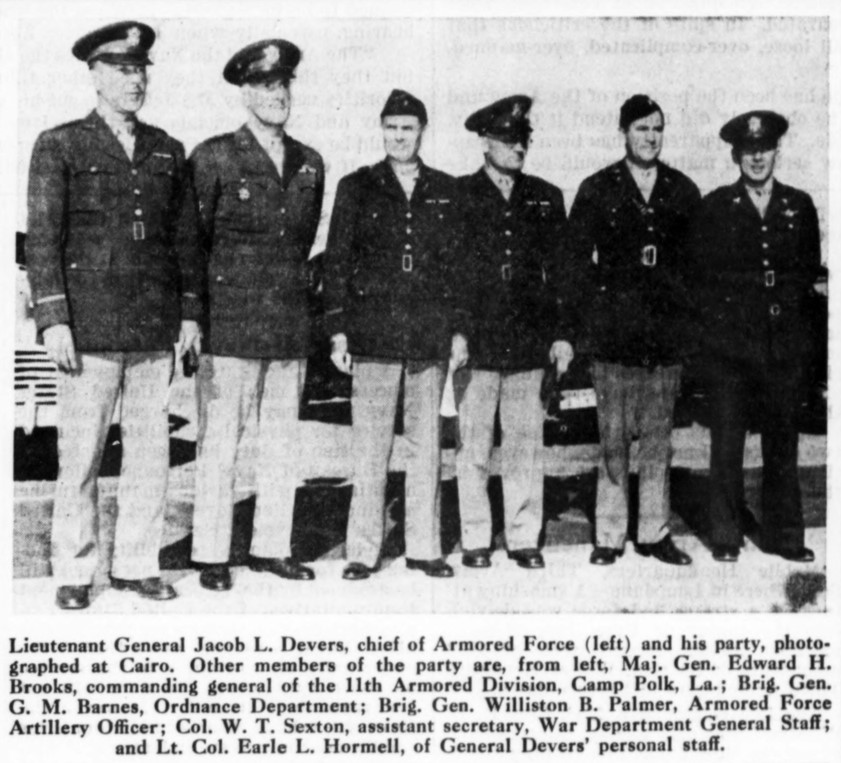
Local man Paul Browne has written a great deal on the subject
and had a website for a time.
The Co-pilot, J Kemp McLaughlin, in 2000 wrote about the flight
in Chapter 5, 'Err'n in Erin', of his book "The Mighty Eighth in
WWII". The narrative is largely the same below reports as
the . Items of note include:
- They had flown from Algiers to Gibraltar prior to
the flight to Europe.
- He implies that they were to fly direct to their original base
at Bovingdon while the witness statements and the men on the day
told Irish officers they were bound for Portreath, an airfield
in Cornwall.
- The flight plan called for a seven and a half hour trip,
leaving at 2am allow night time flight up the coast of France.
He says that the navigator was unable to take any astro shots
due to the cold front they hit on the way up the Bay of
Biscay. This is to be compared to the text in the report
above where he was observed taking many shot. He
goes on to explain that Lt Collins gave them a north easterly
heading at 9.15 am with the intent to hit the coast of England
at 9:45 am. Major Hormell then came to the cockpit and
expressed a concern that the nights weather might have slowed
their progress to a degree that their north easterly flight
might be bringing them over the Brittany peninsula.
At his suggestion, they turned westerly for 30 minutes,
then north and then east again, making landfall at 11:00
am. The radio operator, who McLaughlin says was S/Gt
Teaford, was unable to get a QDM signal response as, in his
words, an RAF night raid was returning so stations would not
respond to QDM calls.
In the archive papers of Lt/Gen Jacob L Devers in the
Eisenhower Presidential Library, there are two narrative reports
prepared after the American Army officers returned to the
UK. One is an informal recollection by an unnamed member
of the party. The map of the route shown below is only for
illustrative purposes, it does not in any way represent any
known actual route.
 On
the following morning the weather was reported favorable at
England and we all again proceeded to the airport at 4:30
for a 6:00 departure stop during the night squalls passed
over Gibraltar creating a strong cross wind and the pilot
balked at taking off in the dark. we decided to wait until
after daylight and when that came the Navigator thought it
was too late to leave. So we all returned to the hotel
again.
On
the following morning the weather was reported favorable at
England and we all again proceeded to the airport at 4:30
for a 6:00 departure stop during the night squalls passed
over Gibraltar creating a strong cross wind and the pilot
balked at taking off in the dark. we decided to wait until
after daylight and when that came the Navigator thought it
was too late to leave. So we all returned to the hotel
again.
That afternoon we were advised that
weather reports indicated that the weather would be splendid
the next morning everywhere - England, enroute, and
Gibraltar. General Devers directed that we be prepared
to leave at 2:00 a.m. before anything else could happen to
the weather. On Friday, January 12, we took off at
2:00 a.m. as planned, with the weather perfect. I was in the
nose of the plane where it was so-cold that it was
impossible to sleep - in fact, I stood up most of the
night. During this period I had ample opportunity to
observe the work of the navigator. He took shot after
shot with a sextant[1].
We were scheduled to strike land shortly after daybreak
which was about 9:00 a.m. At about 10:30 a.m. we did
reach land which the Navigator pointed out as a point about
100 miles north of where we had intended to strike the
southern tip of England. The plane turned and headed
back. After about a half hour of flying, it became
apparent that the ground below us was not similar to any of
our available maps and that there was some confusion as to
where we were. A British sergeant in the RAF who had
been stationed at Malta had been put on the plane (without
authority) for transportation to England. He was
brought into the nose of the plane to look around to see if
he saw any familiar landmarks. His only statement was
“One thing I am certain of is that we are not over Southern
England.” The plane continued to search for a landmark
of some kind which could identify our location. The
ground below was covered with small fields, surrounded by
stone walls, many of them containing sheep. We passed
over several towns and saw trains moving along the
railway. At about 11:30 the navigator told me the
pilot wished us to go into the radio compartment of the
plane. I asked why and he said because we were running out
of gasoline and would have to make a forced landing.
For about fifteen minutes the plane circled an area near a
small town looking for a place to land. Everybody in
the plane prepared themselves for a crash. We tied
ourselves down in the seats, had fire extinguishers ready,
and loosened whatever exits were available. The plane went
into a steep glide, barely cleared some high tension wires
and hit the ground lightly in a grass field. Looking
out of the window I could see us passing some trees and felt
that it had been a successful landing. At that moment
we felt a terrific crash which threw everyone forward and
the plane came to a stop.
Everybody immediately commenced to leave the plane and at
the cry of fire the exit was precipitated. One motor
commenced to burn but was put out with a fire
extinguisher. We found ourselves in a small field
about 50 yards from a two and one half foot thick stone wall
which the plane had gone through. The landing gear and
part of the wings had been sheared off completely and the
plane had slid on its belly for about 50 yards.
Undoubtedly, the only thing which prevented a fatal crash
was the fact that the fuselage cleared the stone wall so
that the undercarriage took most of the shock.
We got out of the plane, found that nobody was hurt, and
could see large numbers of civilians approaching the
plane. When they told us we were in Ireland we could
have been blown over by a feather. Then it dawned upon
us that landing in Ireland made us liable for
internment. The RAF Sergeant wanted to take off for
the brush. Immediately the plane was completely
surrounded by people and shortly thereafter Irish homeguards
armed with rifles arrived and pushed the civilians
back. The wrecked B-17 bomber bristling with
50-caliber machine guns was a source of wonder to the
natives. They were amazed that the party was uninjured, for
the crash had been heard four miles away. The local
priest came up and introduced himself and did not help our
morale by stating, “Well at least you won't have to fight
anymore, and I hope you will find the food alright.”
One Irish woman rushed out, with bandages and asked if
anyone were hurt. When we assured her none of us were
hurt she said, “God bless you all. If nobody is hurt
then I'll run home and get the whiskey!” In a short
time she appeared with a bottle of Irish whiskey and
glasses. The homeguard advised us that we would have
to wait until the Irish military authorities arrived.
In the meantime, upon General Devers instructions, we made
no Commitments as to what we were doing or where we were
going. The people, however, were very friendly.
We assembled our luggage and waited. In approximately
one-half hour Major Tamany [2]
of the Irish Army arrived and at his suggestion we gathered
up our sidearms and turned them over to him. General
Devers, handling the situation, was very masterful and I am
convinced that our release was due in a large measure to his
great tact. A crate of fruit which had been on the
plane was brought out and distributed among the people who
ate it greedily. Shortly thereafter, in transportation
provided by the local citizens, we were taken to the
railroad hotel at Athenry. There we were besieged for
autographs.
The plane had landed at approximately noon and at 2:30 we
were served lunch. General Devers, at the suggestion
of Major Tamany, communicated by telephone with Minister
Gray in Dublin, and was advised that probably the situation
could be handled.
Naturally, we were gravely concerned lest we be interned in
Ireland for the duration of the war. However, it appears
that a working agreement had been made that under certain
circumstances belligerent officers could be released.
Also, it was made plain to us that this was not according to
Hoyle[3] and that the
native inhabitants of the city must believe that we were
being interned.
Shortly after dark, transportation was brought and we
started the drive to the border of Ireland, about 120 miles
away. At about 1:00 a.m., we reached the border and as a
parting gesture were taken into an Irish Army Post and given
a drink. It was noteworthy that as we crossed the
border no guards were in evidence. On the other side
we were met by motor transportation from General Hill’s
Headquarters and immediately continued on toward
Belfast. We arrived there about 10 am, the entire
party having had practically no sleep for two nights.
We had intended to fly from General Hill’s headquarters,
which was located near Lurgan, to London, but their weather
had closed in so we decided to go by boat which left that
night. General Hill was most accommodating - arranged our
transportation and drove us to Belfast where we boarded the
boat about 8.00 p.m. and after a comfortable night trip
across the Irish Channel arrived at Huyshum[4],
England. There we were met by General Hughes and a
special train and taken into London where we were billeted
at Claridge’s Hotel. That night London had its worst
air raid in many months.
[1] J Kemp McLaughlin, as noted below, recorded that due
to the weather, no sextant readings could be made. Perhaps
the person quoted above observed attempts at sextant readings ?
[2] Major Timoney
[3] It is not understood what the author of the report
meant by this word Hoyle.
[4] Assumed to be the port of Heysham, Lancashire.
A shorter two page report formed an appendix to the main report
of the Mission lead by Devers, The mission to examine
problems of Armored Force Units in the Europeans Theatre of
Operations.
The American's were brought to the Belleek border post with
Northern Ireland by Commandant James Power
The purpose of this page is to describe the wartime careers of
the nine American crew members and the British passenger.
There is a little difficulty in identifying the men as the Irish
Army only recorded them by surname and with initials in most
cases. Laurence E Dennis and Johnnie J Tucker both signed
their names in full on the autograph notebook of local student
Paddy Cloonan. Some of the
enlisted men and probably the officers can be seen in this photo
which was taken on the day of the landing in Athenry. The
shape of the arches on the building behind them match with those
of the Railway Hotel in Athenry. Behind the group is the
road embankment up to the bridge over the railway at the towns
station.
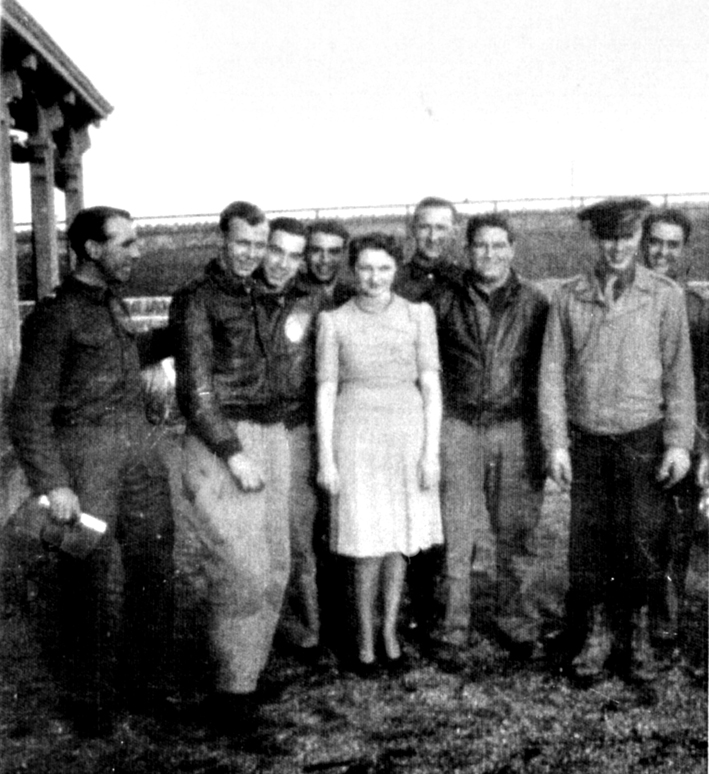
From left of the photo, the first man is a local man, possibly
of the Local Defence Forces (LDF). The next man has been
identified by his family as Sgt John W Tippen. Next to him
is Laurence E Dennis with the white area on his jacket, probably
a unit badge.
Edward Parrish's son's partner identified Edward Parrish Senior
as being third from the right.
Johnnie Tucker's family recognize him as the man on the extreme right of the photo.
Laurence Dennis in his estimation and recollection in 2010
stated he thought those in the photo were:
"L-R Unidentified Irish man,
McLaughlin, Dennis, ??, lady, ?? , Parrish, Hulings,
??. He's thinking two of the unidentified men are
Harris and Collins and perhaps the third unidentified man is
another Irishman.
Larry says during those
days he often would mix up Tucker and Harris, so he's not
certain of their identity in the picture. He figures the
navigator (Collins) is probably in the picture, but he
doesn't know which one. That was the only trip he made with
Collins."
The Harris family did not recognise their father in the photo
above.
The daughter of Maurice Harris provided the photo below of six
men, a better copy of which hopefully can be scanned in due
course, which shows probably six enlisted men. Maurice
Harris is the man kneeling on the lower right of the
photo. Comparing photos, it would seem that Lorin
Blanchard is standing at the left of the photo.

The crew which flew the aircraft too Ireland is said to have
left behind four other crew men due to lack of space. The
waist gun positions at left and right were decommissioned, and
in photos from Athenry, these can be seen to have panels over
with small windows. It is also suggested that the ball
turret on the lower fuselage had been removed. It would be
expected then to have had two officer pilots as well an enlisted
man as engineer, a role understood to have been performed by
Edward D Parrish. Laurence Dennis was the Radio
Operator. At least two men would have manned the upper and
tail turrets.
The known photos of 41-9045 on the ground in Athenry include these two:
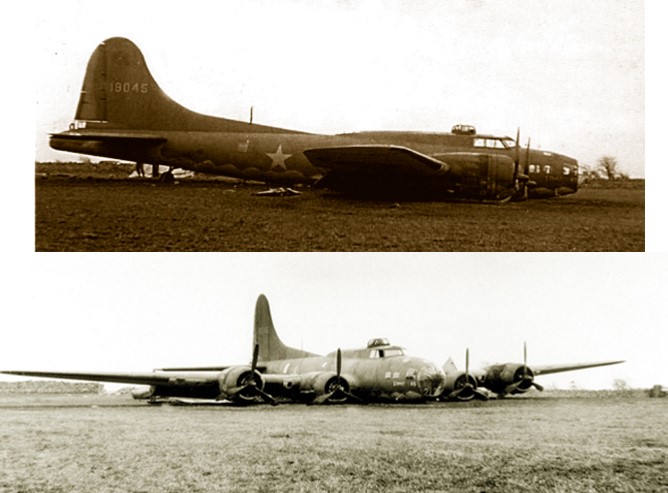
The Americans forming the crew of 41-9045 were:
Capt. Thomas M HULINGS O-437980 - PILOT
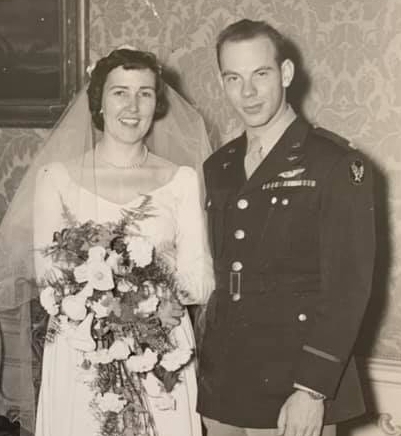 Born on May 5 1920 in Redcliffe to
Arthur F and Amy J Hulings (nee Work). Thomas registered for the
draft in Marienville, Forest, PA and was an engineering student
at the time of the draft, working for the Marienville Glass
Co. He enlisted in July 1941 as aviation cadet, serial
number 13037589 and was later commissioned as officer
O-437980.
Born on May 5 1920 in Redcliffe to
Arthur F and Amy J Hulings (nee Work). Thomas registered for the
draft in Marienville, Forest, PA and was an engineering student
at the time of the draft, working for the Marienville Glass
Co. He enlisted in July 1941 as aviation cadet, serial
number 13037589 and was later commissioned as officer
O-437980.
His local newspapers reported on his wartime career
frequently.
Warren Times Mirror on Feb 28, 1942 reported his having accepted
his commission as a 2nd Lieutenant. He is mentioned in the
book "Grey Ghost" as having flown a bomber to England as one of
the first members of the 407th Bomb Squadron in late August
1942.
The Oil City Derrick on May 20, 1943 reported on his having been
the judge of a model aircraft competition for English
boys. His obituary in 1998 mentioned that on his first
mission enemy action severely wounded five of his crew and his
plane had more than 2000 holes, an incident featured in a
Ripley's 'Believe It or Not' cartoon. This mission it is
believed was the October 9th, 1942 raid on Lillle, France.
Lt Hulings was flying that day as the Co-pilot to Captain James
J Griffith Jr, when their aircraft received severe flak
damage. The story of the crew was used by the USAAF as the
basis for a widely printed newspaper release. While Lt
Hulings name is not mentioned in this widely publicized
experience, the pilot's son was able to recount his fathers war
time missions.
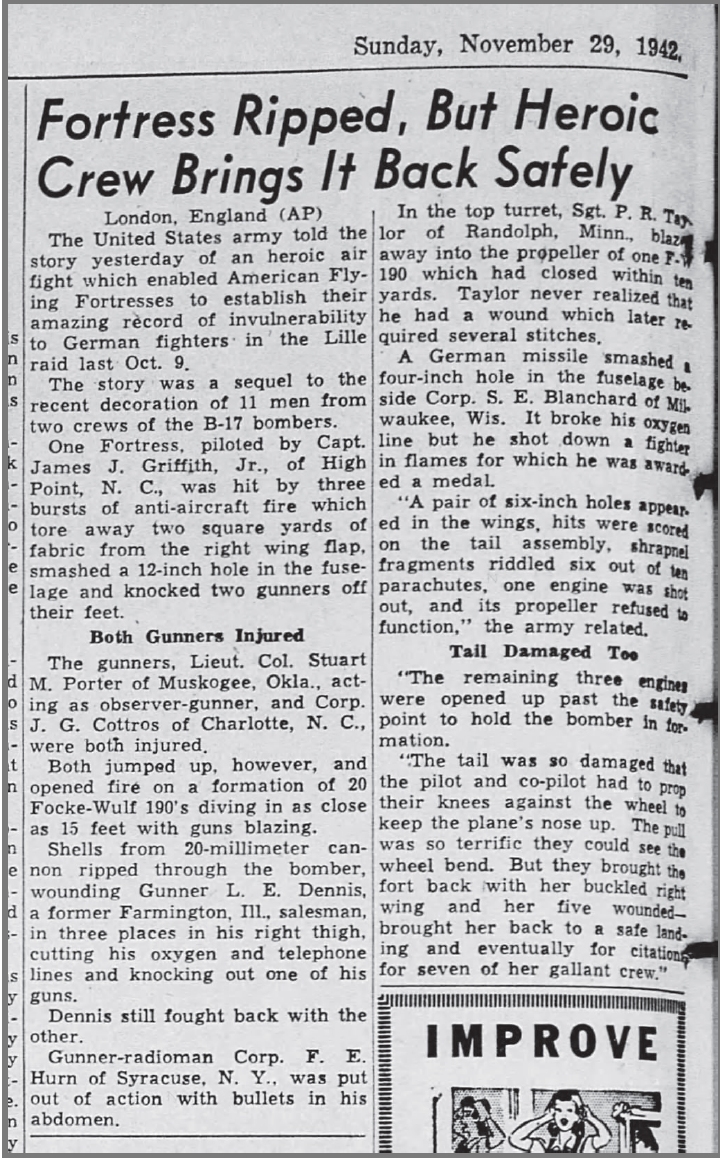
 The Oil
City Derrick on Nov 4th, 1943 reported that he had informed his
parents that he was staying on in Europe with Bomber Command for
further duties, having previously said he would return to the
US.
The Oil
City Derrick on Nov 4th, 1943 reported that he had informed his
parents that he was staying on in Europe with Bomber Command for
further duties, having previously said he would return to the
US.
Many Pennsylvania papers then on November 26th 1943 carried
reports of his completion of his first tour of duty.
He rose to the rank of Major during the war and later served as
commander of the 368th Bomb Squadron in the 306th Bomb Group
from October 1944. There he completed another 14 missions
following on from his 25 with the 92nd Bomb Group earlier in the
war. He then moved onto the British built Mosquito twin
engine aircraft flying recon missions with the 25th Bomb
Group.
His veterans compensation form in 1950 states he was overseas
from August 24, 1942 to November 17, 1945. His parents
were deceased at that time and he was married to
Katherine. He had married on October 24, 1944, to Captain
Katherine Young, Commanding Officer of the 8th Air Force
Headquarters WAG Detachment.
He later flew 14 missions with the 306 Bomb Group, then flew
Mosquito Recon with the 25th Bomb Group. After hostilities
ceased he participated in the Casey Jones mapping project On
October 24, 1944, Major Hulings married Captain Katherine Young,
Commanding Officer of the 8th Air Force Headquarters WAG
Detachment.
After the war, he worked for Dupont in technical sales for 12 years and for Hercules Powder Company for 23 years before retiring in 1985. Mr. Hulings was active in the Georgia Chapter 8th Air Force Historical Society, Silver Wings, and the Middle Georgia Soaring Association. He was an avid photographer. He passed away on the 8 July 1998 in Georgia and was laid to rest in the Cemetery in Provincetown, MASS.
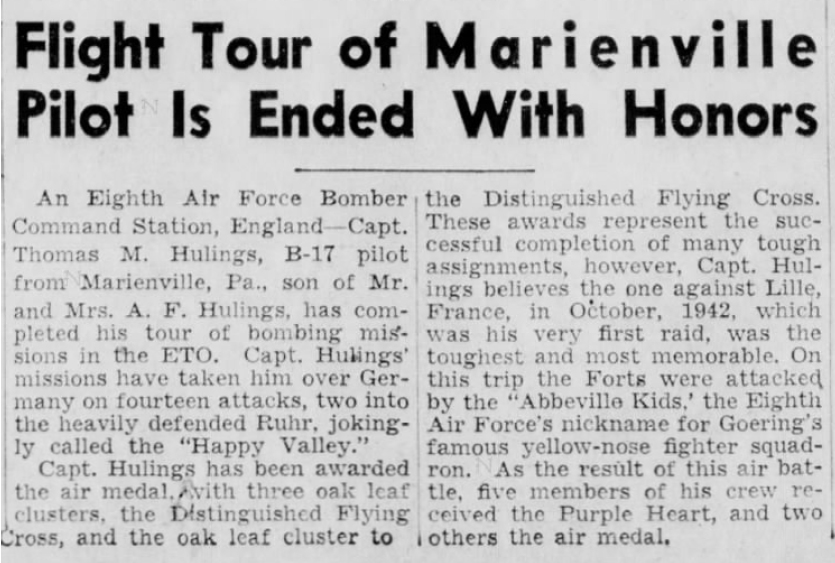
2/Lt J. Kemp MCLAUGHLIN CO-PILOT O-789398
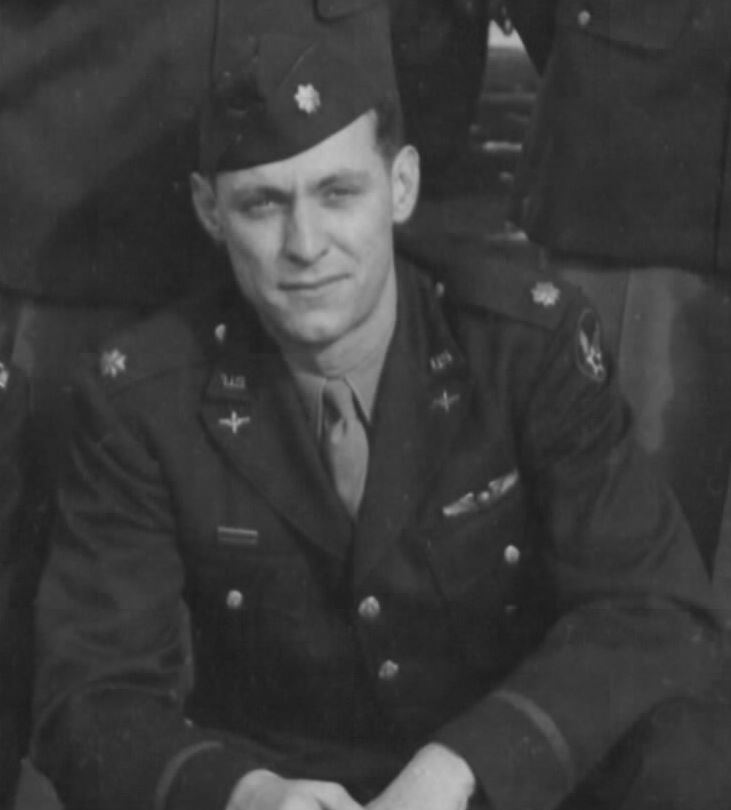 James Kemp
McLaughlin was born in 1918 in West Virginia to Almira Ballengee
McLaughlin and James Blaine McLaughlin.
James Kemp
McLaughlin was born in 1918 in West Virginia to Almira Ballengee
McLaughlin and James Blaine McLaughlin.
He published his wartime memories in his book, "The Mighty Eighth in WWII: A Memoir"
published first in 2000 and included a chapter that told of the
his impromptu visit to Ireland.
An interview given by him in 2016 can be viewed here on
youtube:
The following 1944 extract from the 92nd's records mentions the
then Major McLaughlin. 31
Officers and 40 enlisted men completed tours of duty.
On April 19, Major Julian R. Thornton, Jr., Group
Bombardier, and Major James K. McLaughlin, Asst. Group
Operations, after having completed their initial operational
tours, left on 30 day leave. Destination:
USA. Upon their return, they will begin an additional
tour.
J Kemp McLaughlin passed away in West Virginia on the 16
December 2019 in his 101st year. The following tribute
video detailing his service career, both during and after the
war.
2/Lt Clyde B COLLINS O-789458
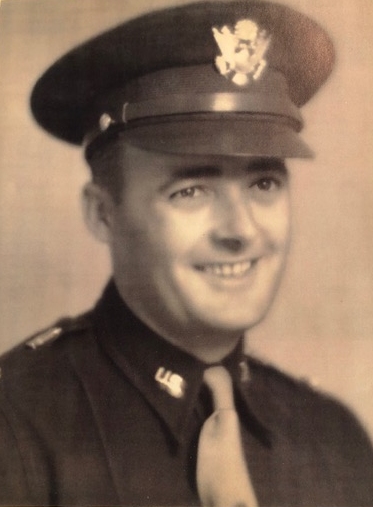 This member of the crew was recorded by the Irish
army only by rank, initials and surname and by his position of
navigator in the crew, Lt C B Collins. Kemp
McLaughlin mentions him as Clyde B Collins and also that he had
been bunk mate of his during their pilot training. Based
on this, and the enlistment in 1941 below of a Clyde B Collins
from Kentucky, the following bio has been created with the help
of his family.
This member of the crew was recorded by the Irish
army only by rank, initials and surname and by his position of
navigator in the crew, Lt C B Collins. Kemp
McLaughlin mentions him as Clyde B Collins and also that he had
been bunk mate of his during their pilot training. Based
on this, and the enlistment in 1941 below of a Clyde B Collins
from Kentucky, the following bio has been created with the help
of his family.
Born in 1915 to Willard and Cora Collins, nee Bentley.
His local newspapers tell much of his wartime story. He
enlisted in September 1941 at Fort Thomas, Newport, Kentucky as
a cadet. He is listed as a sales person upon
enlistment. His local newspaper reported on this wartime
activities during 1941 thru 1943. The Cinncinnati Enquirer
on August 24th, 1941, lists him among a list of airmen cadets
being posted to the Cadet replacement Center at Maxwell
Field, Alabama for training.
In September 1941 the Mountain Eagle paper reported on him as
follows:
"Clyde B Collins Goes Into Training At
Maxwell field.
Army Aviation Cadet Clyde B Collins, son of Mrs Cora
Collins, 371 Woodland Ave., Lexington, Ky., has started
pre-flight training at the Initial Training School, Maxwell
Field, Ala., it was announced last week at Fifth Corps Area
Headquarters, Fort Hayes, at Columbus, Ohio.
Enlisted at Fort Thomas, Ky. Collins will spend one
month at Maxwell Field with others of the October Aviation
Cadet class before transferring to a primary pilot school.
The pre-flight course is designed to equip cadets with
fundamental schooling in military and scholastic subjects
thus giving them more time for actual flying at air schools.
Collins was graduated from Whitesburg High School, at
Whitesburg, Ky., and attended Georgetown College and the
University--' of Kentucky. He has been associated with the
D. J. Davis Co., Lexington.
Army Aviation Cadet scholarships, worth $25,000 each,
are awarded to'single men at least 20 years old and not yet
27, who are physically and educationally qualified. More
than 325 of these scholarships are awarded each month to
eligibles in Kentucky, Ohio, Indiana and West Virginia."
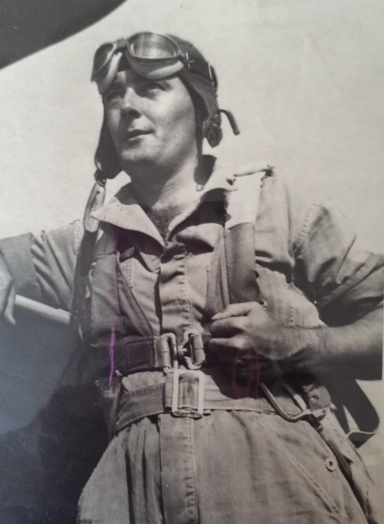
On 2nd July 1942, the Mountain Eagle was reporting on his
wedding:
"The wedding of Miss Susan Baker
Stivers, daughter of Mr. and Mrs. Robert Stivers, to Lieut.
Clyde Bruce Collins, son of Mrs. Cora Collins of Lexington,
was solemnized at 10 p. m. Saturday, June 20 at the home of
the Rev. Claud T. Ammerman at Sarasota, Fla. The home was
beautifully decorated with ferns and a profusion of garden
flowers.
The bride was becomingly attired in a sheer "white
dress with white accessories and a shoulder bouquet of pink
rosebuds.
The attendants were Lieutenant and Mrs. Richard G.
White, Jr., and Lieutenant and Mrs. C. W. Knops.
Miss Stivers attended Henry Clay high school in
Lexington and Lieutenant Collins attended the University of
Kentucky.
The couple will reside in Springfield, Mass., where
Lieutenant Collins is now stationed.
Note - Mr. Collins who is well known here is a grandson
of Uncle Elberson Bentley of He is a graduate of the
Whitesburg High School."
The last mention of him found so far was this from early
November 1943:
"Clyde B. Collins of Lexington, who is
now an instructor in navigation with the United States Army
Air Forces stationed in Ireland has been promoted from first
lieutenant to Captain. Captain Collins
has been In the air forces two years and and overseas 13
months. He has taken part in several raid over enemy
country."
In 1937, directory for Lexington appear to have him working as a clerk at the McAdams and Morford chemical company. The 1940’s census has him living at home with his widowed mother Cora and sisters Jean and Bernice. Throughout the 1940’s and 1950’s Lexington Kentucky directories list him and wife Susan living in the city, with Cora his mother also living nearby. Employed by the Lex Signal Depot.
Clyde passed away on 9th December 1968 in Fayette. His
headstone is marked as Lt Col, Clyde B Collins, with service
attributed to WW2 only. He had remained in the Air Force
reserve post war raising to the rank shown on his
gravestone. The photo below shows him standing next to a
Fairchild C-119 Flying Boxcar transport of the US Air Force.
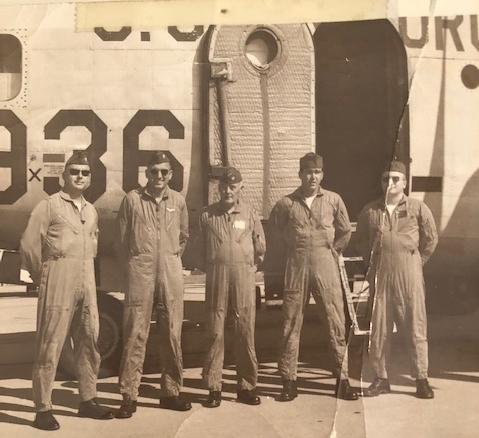
Sgt Lorin E BLANCHARD Jr. 16048807
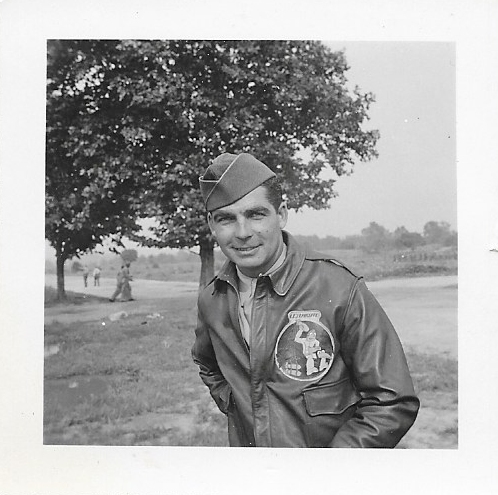 Lorin was
born 16 Mar 1914 in Milwaukee, Wisconsin to Lorin and Ruby
Blanchard. In 1940, he is living with his widowed father
in Milwaukee, and working as a clerk in a Life Insurance
company.
Lorin was
born 16 Mar 1914 in Milwaukee, Wisconsin to Lorin and Ruby
Blanchard. In 1940, he is living with his widowed father
in Milwaukee, and working as a clerk in a Life Insurance
company.
He enlisted in January 1942 into the Army Air Corps. He is
believed to the the airman widely published in American
newspapers as "S E Blanchard" in November 1942, in a news story
about the 9th October 1942 raid on Lille. The article can
be seen above in Thomas Hulings bio.
After his return to combat he was awarded the Air Medal and
listed in the June 1943 copy of Air Force News.
The Lake Geneva Regional news of Dec 3rd 1942 reported on the
award of a "Hero Medal" to a Coorporal Lorin B Blanchard, son of
the late Ruby Dowes Blanchard from Milwaukee.
The 92nd Bob Group history lists a S/Sgt Lorin E Blanchard
having a reclassification Military Occupation Specialty (MOS) in
daily order for January 24th 1945 while serving still with the
407th Bomb Squadron.
He married Jane Baynard Martin in 1948 but the marriage broke
up and Lorin moved to Detroit, Michigan where he died 30 Nov
1980. He lived for many years on a houseboat
in the Detroit River and never remarried.
His family very kindly provided the wonderful wartime photo of
him above where the
Sgt Johnnie J TUCKER 14068147
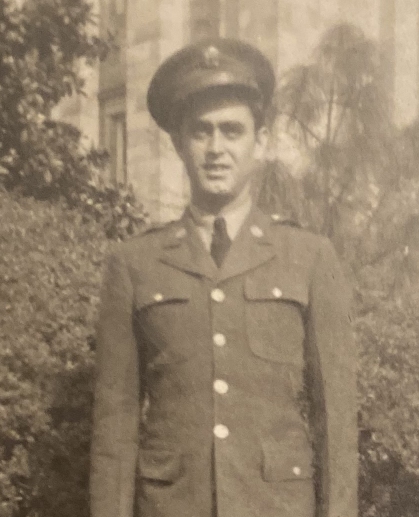 Born
in North Carolina in 29 Apr 1919 to Hallie V and Joseph C
Tucker. His full name was Johnnie Joe TUCKER
Born
in North Carolina in 29 Apr 1919 to Hallie V and Joseph C
Tucker. His full name was Johnnie Joe TUCKER
During the war, his next of kin was his wife, Edith M Tucker
(nee Munford), living at 514 Carr St, Durham.
He enlisted in January 1942 at Fort Bragg and at that time was married and working as a salesman.
He was shot down on 14 May 1943 flying on B-17F 42-30003 under
1/Lt Lowell W Walker. They were taking part on a bombing
raid against the U-Boat pens in Kiel, Germany. Records for
the loss are poor, other than 407th Bomb Squadron/92nd Bomb
Group records state: "The ship
was last seen circling down under control toward Amrum
Island with one engine out and a stabilizer shot off."
Missing Air Crew Report 16055 was filed for this aircraft
and a copy is sought.
He is pictured here with his wife Edith in 1940.
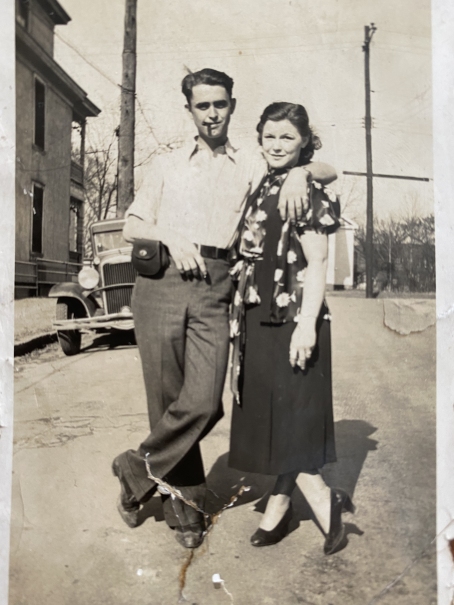
A set of photos kept by his relatives were likely taken some
time in 1942 perhaps after graduation from his Army Air Forces
training. They show him with his mother Hallie and his
brother Grover in the grounds of Duke University, Durham, which
was near his mothers home.
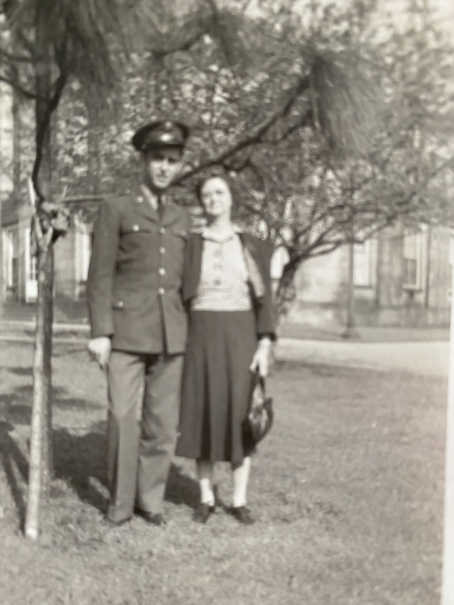
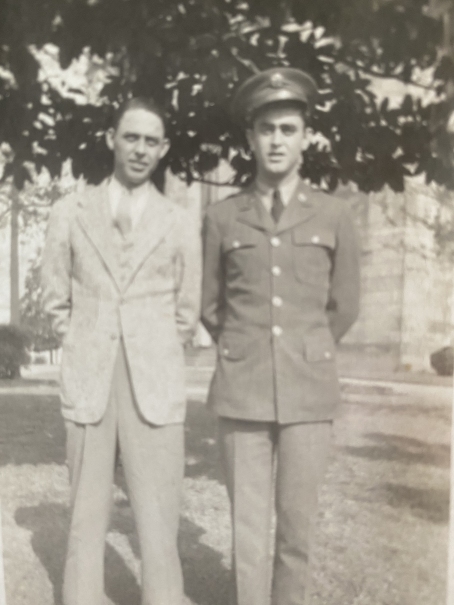
Newspaper reports of his capture in June 1943 recorded his
address as 909 Virgie St, West Durham.
Johnnie spend the remainder of the war as a POW in Germany and
after his release, arrived back in New York on the SS Monticello
3 Jun 1945. On that shipping manifest his address is given
as 810 Vickers Ave, Durham, N.C.
Johnnie passed away 28 December 1978 in Durham, NC, and he was
buried in Liberty Christian Church Cemetery, Epsom, Vance
County, North Carolina. Edith, his wife, died on 15
March 1998.
In this photo, Johnnie is seen with an unidentified colleague,
which the family understand might have been taken at Fort Bragg.
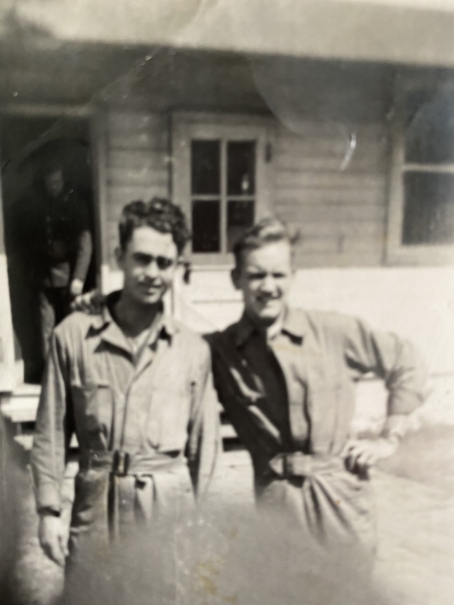
Sgt John W TIPPEN 14033646
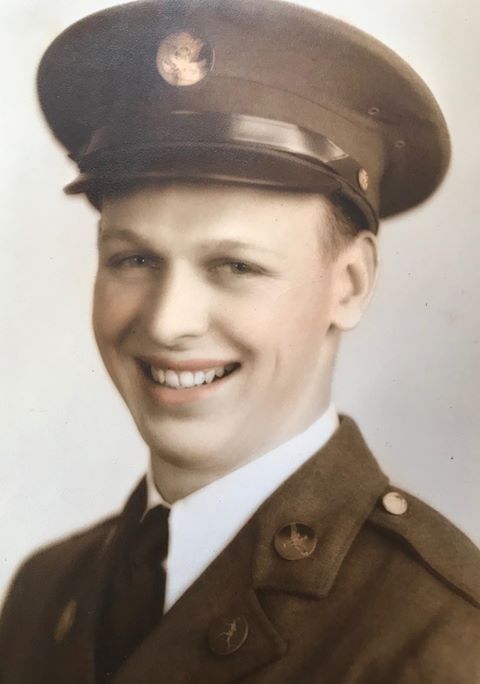 John was born 1921 in
Birmingham, Alabama, to Mabel and John Tippen.
John was born 1921 in
Birmingham, Alabama, to Mabel and John Tippen.
He enlisted in the Army Air Corps in November 1940 aged 19 and
his service continued through until September
1945. During the time he appears to have
remained within the 92nd Bomb Group, moving between Squadrons
during 1944.
He had arrived back in the US at the port of New York on the
19th of July 1945 on the SS Aquitania. On the manifest for
the arrival, he is recorded as having a Military Occupation
Speciality (MOS) of 911, which indicated Aircraft
Armourer. He had married in June 1942 in Florida and in
1945 was living at 1248, 15th St, South West Birmingham.
It was only upon he arrival back home that he was required to
register for the draft and he did so again in Birmingham,
Alabama in September 1945. He listed himself as
unemployed.
He passed away on 6 Jan 2003 and is buried in Elmwood Cemetery,
Birmingham, Alabama.
Sgt Maurice L. HARRIS 15084594
The identity of the airman recorded by the Irish army simply as
"Sgt L Harris". McLaughlin in his book does record him as
Maurice L Harris. His daughter was able to say in 2011
that he had kept various newspaper cuttings dated in November
1942, recording his air medal award. Based on this
information it was determined that he was the airman described
below.
Born on Dec 27 1918 in Indiana to Arthur and Harriet (Nee
Thornberry) in Vigo County, Indiana. Arthur, his father
died in January 1924 in a rail road accident and his mother
remarried Grover Stephens. He in 1940 is found on the
census, XXXX. His enlistment was on 5th January 1942 in
Fort Benjamin and was into the Army Air Corps, at that time
getting the Army Serial Number 15084594 . In November
1942, American newspapers reported on his award of the Air Medal
for gallantry in action. At that time his address is given
as Rural Route 2, Shelburn. Among the information in the
newspaper clippings are that he had enlisted in December 1941
and had departed for his training base on January 3rd,
1942. His army serial number was recorded on some of his
surviving documentation, and he also that he was a rear gunner
and had flown at least 25 combat missions. He had also
kept a group of ten postcards of Algiers.
Maurice passed away on 19 March 1969. He is buried
alongside his widow, Elizabeth L Harris, who died in 2000.
T/Sgt Edward D. PARRISH 06151908
With no serial number recorded, this mans name was recorded by
the Irish Army as E D Parrish or Edward D Parrish.
Following contact made with a family member, it has proven
possible to confirm Edward D Parrish as the airman described
below.
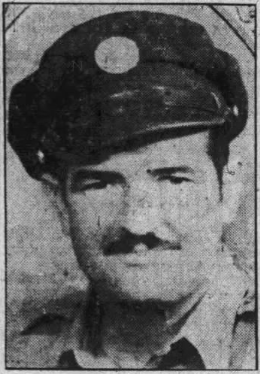 Edward Dexter Parrish was from
Saugus, Essex County, Massachusetts. Born in April 1925,
he was the son of Robert and Lilla Parrish. The U.S.,
Department of Veterans Affairs BIRLS Death File on ancestry.com
lists him having an enlistment date of 19 December 1939, and a
release of 1 October 1945, with the Air Force indicated as the
branch of service.
Edward Dexter Parrish was from
Saugus, Essex County, Massachusetts. Born in April 1925,
he was the son of Robert and Lilla Parrish. The U.S.,
Department of Veterans Affairs BIRLS Death File on ancestry.com
lists him having an enlistment date of 19 December 1939, and a
release of 1 October 1945, with the Air Force indicated as the
branch of service.
His local Saugus town newspaper reported on his and his two
brothers services during the war, with a July 1945 article
featuring the story of how he and brother Charles met up after
four years apart in while both were visiting their parents.
SERVICE BROTHERS MEET
M. Sgt. Edward D. Parrish of 54 Clifton street, son of
Mr. and Mrs. Robert W. Parrish, recently was home on a
30-day furlough.
During this period his brother, Charles L. Parrish,
radarman 3/c, who has been away for four years, came home
from California by airplane.
Sgt. Parrish, AAF ground crew chief, has been overseas
for 38 months and was in the first plane of the Eastern
Command to land in Russia. From Russia he traveled 8000
miles by truck to Egypt.
He has a Presidential citation and five battle stars.
Robert W. Parrish enlisted in the Navy a year ago and
has seen action in the Philippines, Iwo Jima and Okinawa. He
was stationed on the U. S. S. LaGrange. He is the husband of
the former Lillian Carney of Melrose.
Both service men were graduated from Saugus High
school.
The US Archives enlistment data records him having reenlisted
in 1945. He remained in the services after the war and the
photo shows him in US Air Force uniform in Japan in the early
1950's.
He passed away in October 1997 in Bedford, Massachusetts.
Edward married Marrietta Clara Beeck in 1949 and they are seen
below with their only son Edward Junior in Japan in
1952.
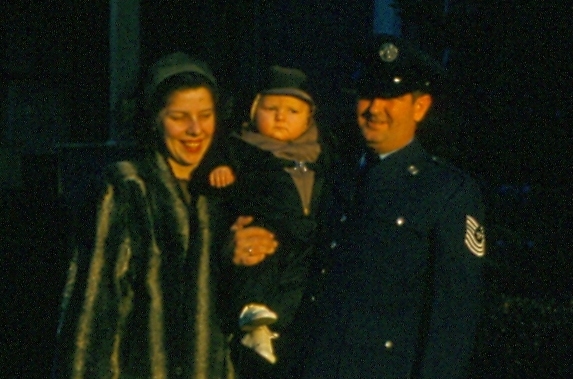
Edward again in uniform but in a more relaxed setting seen
again in a post war photo.
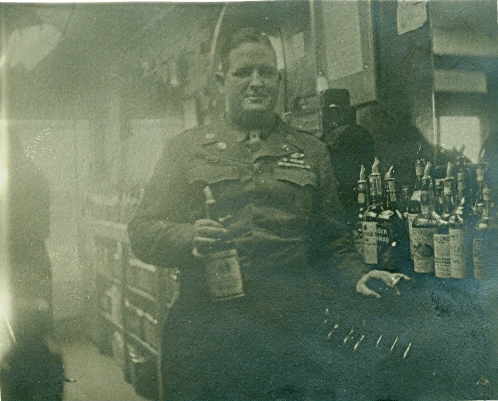
T/Sgt Laurence E. DENNIS Jr 36048962 POW
This airman's name is confirmed as being aboard the aircraft
from his own testimony later in life. 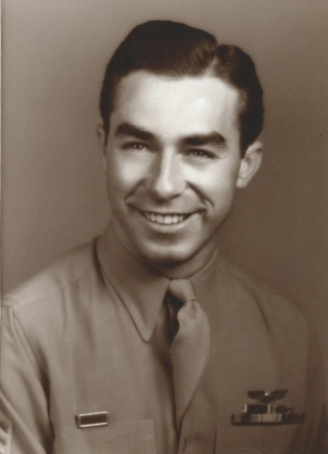
Laurence was born in 1918 in Illinois, the son of Laurence Sr.
and Alice (Harrison) Dennis. He graduated from Farmington
Community High School in the class of 1936.
He was, like the other crew members, posted to the 92nd Bomb
Group.
He was the radio operator on aircraft when it landed in
Galway. Laurence in his recollections in later years
remembered General Devers being on the flight, but he felt that
Gen Devers was the only passenger. In his own words from
correspondence in 2010 with the 92nd Bomb Group historians:
Now my side of the story. I remember this flight very well for a couple of reasons. It was the very first time I was called upon, as a radio operator, to help a navigator determine our locatin or secure a course.
Most of the time he rode in the nose
and bothered the navigator. But he came back to the radio
room and asked if I had contacted anyone yet? I told him
"no"—his answer. "What the G__ D__ hell kind of radio
operator are you??!!" I offered him the headphones but he
wouldn't listen—went back up front. I figured it was a bit
unusual for an Air Corps radio operator to have his butt
chewed out by a Tank Corp general, so I've never forgotten
it. We had nothing but rain and fog for 4 or 5 hours on that
trip. Static was terrible.
He recalled also in the 1990’s that after the landing, the local
school master brought the whole group of children to see the
aircraft and the crew were able to share with them a carton of
oranges they had in the aircraft.
After the stint flying between North Africa and the UK, he
returned to combat duties in April 1943 with the 92nd Bomb
Group. He and his crew were forced to ditch their B-17,
42-29965, in the English Channel on the 6th of September
1943 returning from a raid on Stuttgart.
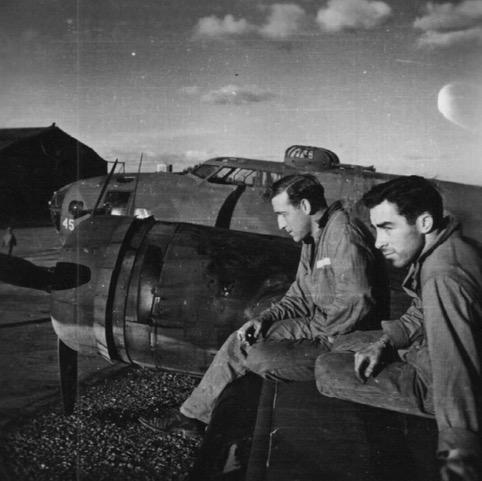
In the photo above, Laurence can be seen nearest the camera,
with an unidentified airman inboard. On the nose of the
the B-17 one can read the numbers 45, which makes it most likely
that the photo shows the aircraft which landed in Athenry, B-17E
serial number 41-9045.
On the 16th of November 1943, the 407th Bomb Squadron aircraft he was crew on, began the suffer technical problems, and he and his crew mates were forced to bail out over Norway. This was his 23rd mission and he was a POW for 18 months at Stalag 17B. The photo below is his German prisoner of war 'mugshot' from this time.
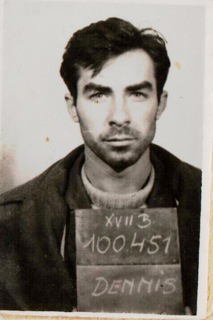
Laurence passed away 9 Dec 2015 in Peoria, Illinois in his 97th
year.
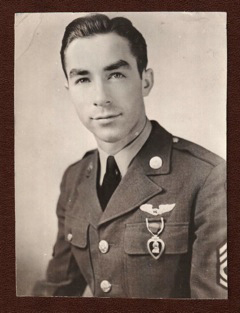
In his book, The mighty Eight, J Kemp McLaughlin records that the Radio Operator on 41-9045 when it landed in Ireland was "Edward E Teaford". In the 92nd Bomb Group at this time there was a S/Sgt Everett K Teaford who was later shot down and taken prisoner with Johnny J Tucker in May 1943.
In 2011 Laurence was able to return to the skies in a B-17
when the he was able to take a flight in the B-17 'Sentimental
Journey' flown by the Commemorative Air Force.
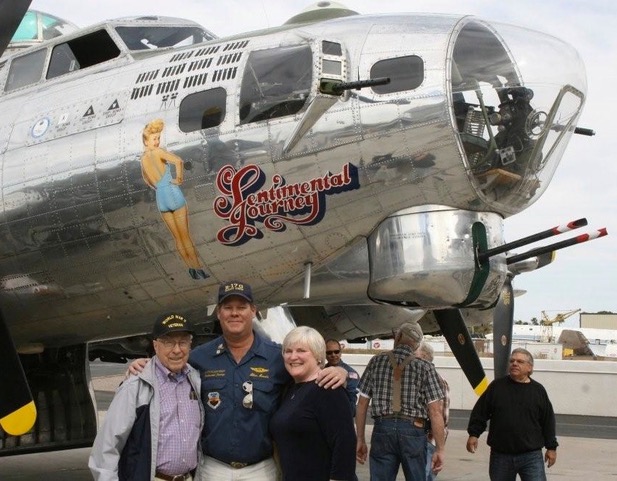
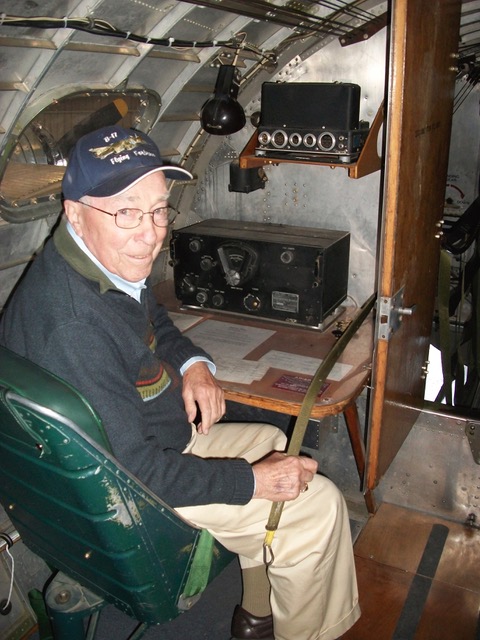
Among the passengers on the aircraft was a lone British pilot, returning from a tour of duty abroad.
Sgt Reginald Charles BOLLAND 625196
The final name found to have been a passenger on the aircraft
is described by the Irish Army report variously as, "Sergt. R.
Boland, R.A.F." and Pilot-Sergt. R. Boland R.A.F." The
report filed by General Devers mentions him as follows: "A British sergeant in the RAF who had been
stationed at Malta had been put on the plane (without
authority) for transportation to England."
J Kemp McLaughlin describes this man in his book published in
2000 as "One
of our passengers was British Flying Sgt. R.C. Bolland,
hitchhiking his way home from a three year tour as Spitfire
pilot on Malta."
It would seem most likely that he was Reginald Charles Bolland 625196, a fighter pilot who went missing in October 1944 while flying with 504 Squadron.
He was one of the pilots who flew off HMS Furious on 11th August 1942 in a Spitfire to reinforce the defense of the island of Malta. His posting in to 185 Squadron is mentioned only briefly in the ORB, in so much as three named officers and "four Sergeant pilots report for full flying duties with the squadron."
His first apparent mission was on the evening of 25 August
1942, on a 10 aircraft patrol.
He was previously flying with 242 Squadron in the UK and is
listed along with two other pilots, Sgt Sullivan and Harrison,
as being posted overseas as of 3rd August 1942. In 242
Squadron he appears to have been mainly training.
The Squadron Operations Book of Royal Air Force 285 Squadron on
the 2nd February 1943 recorded the posting in of 625196 Sgt
Pilot R C Bolland from 2 PDC for flying duties. This unit was a
non front line Squadron that was tasked with flying target
towing duties and other support missions using a variety of
aircraft types. Reginald was twice commended while serving
with the unit.
On the 13th of April, he was flying a Defiant tug when it
suffered an engine failure above cloud. He managed to
bring the aircraft in for a safe landing at Ringway aerodrome
with no damage.
The 10th of July 1943, while based at RAF Woodvale with a
detachment of the Squadron, Sgt Bolland again displayed his
piloting skills. The ORB records as follows: "...a transatlantic Liberator in
difficulties owing to fog and ?????? and was endeavouring to
land at Woodvale, after being homed by a nightfighter.
625196 F/Sgt Bolland ?.?. of this unit offered to go up in
an Oxford and bring the Liberator in. He was refused
permission at first but was eventually allowed to go and he
brought the Liberator in successfully and without mishap.
His luck turned the following month when he suffered an
accident while flying Miles Martinet MS507 leaving him
injured. On 28 August 1943 while taking off from Woodvale
in the Martinett target tug when his engine cut out at 250
feet. He attempted to land in a field but due to lack of
height, he instead crashed into a barrack hut in Harrington
Barracks, Formby. He was rescued from the cockpit by three
solders, Sergt. G. R. Elkin, of the East Lancs Regt.; Pte. J.
Conroy, of the King’s Regt, and Private T. Kennedy, South Lancs.
Regiment. Newspapers of October 1943 carried the story of
the three soldiers rescue efforts, noting that they found the
pilot on the wing of the burning aircraft. He was posted
out on the 22 October 1943 to RAF Station Uxbridge.
The now Warrant Officer R C Bolland was posted to 504 Squadron
on the 1st of September, 1944 from 53 OTU. On the 13th
September, he flew an escort mission to Osnabruke. He flew an
escort mission on September 17 supporting the airborne landing
at Arnhem. He flew one weather recon mission in Spitfire
PL432 on the 18th September. He flew a Ramrod mission
escorting Halifax bombers to Duisberg on 14th October with 11
other aircraft and pilots.
On 19th October 1944 W/O Bolland took off in Spitfire PL432 in
the morning at 07:30 hours on a weather Recce mission with F/O G
Strange. F/O Strange flew from the 504 Squadron base at
Manston, Kent to, Rotterdam, Amsterdam, Orfordness and then back
to base. W/O Bolland however disappeared and is simply
recorded as F.T.R., failed to return.
The ORB summary recorded as follows:
WEATHER: cloudy with strong winds,
improving towards evening. OPS. two early morning
weather recce were flown by "A" flt. Yellow Sec. covered the
area Ghent-Maastrect-XXXX, without incident. Red Sec.
(FO Strange & W/O Bolland) covered the
Rotterdam-Amsterdam area. On the return journey, when
about 25 miles off Ijuiden, at 15-20,000' in heavy XXXX
conditions, F/O Strange's R/T set was rendered u/s. It
is thought that W/O Bolland's set was affected in the same
way as he did not call up to say that he was in trouble.
His remains were never recovered and thus his name is recorded
on the Runnymede Memorial. The CWGC available records
don't list any next of kin. However, the surname spelling
being somewhat unique, compared to 'Boland', points towards a
man born in Fulham district, London in 1919 to a couple named
Edith Phyllis (nee Barnes) and Reginald Cass Bolland. His
father, Reginald Bolland, died in 1919 however.
Reginald is found in the 1939 Register as a 20 year old RAF
Aircraftman 1st Class living with a couple, Charles and Fanny
Bolland Mount Road, Wallasey, Cheshire, assumed to be his
grandparents. Interestingly, his serial number is written
on the register entry. In August 1930 his widowed mother
was found to have married, in Amsterdam, one Mathieu van den
Abeelen. One witness to the marriage was a James Patrick
Power, a well known artist of his time and who may have been
married to a sister of Reginald's but it is unclear if he was
related.
The passengers on the aircraft, the party traveling with Lt/Gen
Devers, are all well known US Army officers, and in some cases
need little introduction.
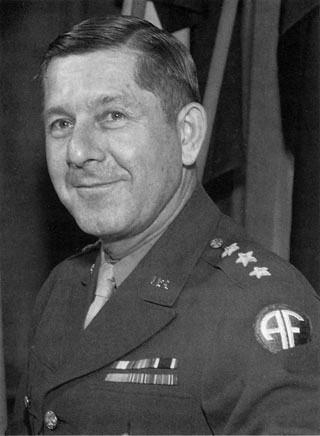 Lt/Gen
Jacob Loucks DEVERS O-2599: The following career
summary for Jacob Devers comes from the papers index
published by the Eisenhower Library in Abilene, Kansas.
Lt/Gen
Jacob Loucks DEVERS O-2599: The following career
summary for Jacob Devers comes from the papers index
published by the Eisenhower Library in Abilene, Kansas.
General Jacob L. Devers (1887-1979) was born at York,
Pennsylvania, and graduated from the U.S. Military Academy
at West Point in 1909. He held a number of field and staff
positions in the U.S. Army and also taught for several years
at West Point. In July 1941 he became commander of all U.S.
armored forces and was responsible for preparing the tank
corps for battle. One of his subordinates was General George
S. Patton, who had been his classmate at West Point.
In May 1943 Devers was sent to England
where he became commander of U.S. forces in Europe and
helped make initial preparations for the Normandy Invasion.
After Dwight D. Eisenhower became Supreme Allied Commander
in January 1944, Devers was transferred to the Mediterranean
Theater where he served as Deputy Supreme Commander under
General Henry Maitland Wilson. In September 1944 Devers
became commander of the Sixth Army Group, which was
responsible for the invasion of southern France. The Sixth
Army Group attacked northward up the Rhone Valley and joined
with Allied forces in northern France in mid September. It
then attacked eastward into southern Germany and Austria.
After the war Devers returned to the United States and
served as chief of Army Ground Forces until his retirement
in September 1949.
More information about him can be found in books and in papers
and videos online, a tiny sample is provided below:
Defense Technical Information Center: Strategic Leadership
Assessment of General Jacob L. Devers
Jacob L. Devers: A General's Life, by James Scott Wheeler
(Author), Rick Atkinson (Foreword)
General Jacob Devers: World War II's Forgotten Four Star, by by
John A. Adams (Author)
The following newspaper article is of interest in that it
revealed the wartime event in American press in 1957.
Long Secret Adventure Of York
General Told
YORK, Dec. 21 - A long-classified story of a World War II
episode involving Gen. Jacob L. Devers, native Yorker,
appeared for the first time in print here this week in the
December issue of the White Rose Motorist, official
publication of the White Rose AAA Motor Club.
The club granted permission for the Sunday News to
re-tell the story as related by the general and his sister,
Miss Catharine Devers, a member of the motor club staff.
Last spring Miss Devers met in Ireland a man who saved Gen.
Devers and five other high ranking American officers from
spending the duration of the war in a
neutral Irish prison.
A few weeks after Christmas, 1942, General Devers, two other
generals, one brigadier and two colonels were aboard Gen.
"Toohey" Spaatz' personal plane en
route from Gibraltar to London.
To avoid encountering German fighters, the navigator had
mapped a course over water which became a nightmare for the
pilot who soon was lost. A navigational error had placed him
in the embarrassing position of having to tell four generals
and two colonels he wasn't sure if they were flying over
England,
Scotland, Ireland or occupied France.
When the fuel supply ran out, the pilot picked a small field
near a village and set the plane down, striking a stone wall
at the far end of field. Nobody was injured,
but the "brass" was concerned as to its whereabouts.
In a matter of minutes a man on horseback dressed in a Home
Guard uniform rode up. Gen. Devers asked the question as to
location, and the Home Guard captain's reply was "South
Ireland."
By every rule in the book the story should have ended there
with the officers' internment for the duration of the war.
But as a crowd gathered, nobody seemed
to know what to do.
Gen. Devers said, "I spotted a big man with a kind,
intelligent face. He looked just like my Irish grandfather
who was a blacksmith. I struck up a conversation with him."
The man turned out to be the village doctor, and he told the
York officer not to worry. "You'll be alright, General." the
doctor said. "My own son is in the Royal Navy, and 80 per
cent of us have sons in the war. We're with you all the
way."
After a brief chat between the doctor and the captain, the
"brass" was escorted to waiting automobiles and taken to the
village inn where the officers were
given the best accommodations available.
That evening they were treated to a huge banquet in the town
hall, and after a night's sleep they were awakened early in
the morning and were told that a motor cavalcade was
awaiting them for the trip to the border. The entire village
turned out to see them off.
The motorcade took a turn around the square, and then headed
toward Northern Ireland. Once the officers arrived there it
was an easy matter to secure boat passage to Scotland and
London.
Miss Devers, who visited with the captain of the Galway Home
Guard on a visit to Ireland this year, said that his actions
during the incident involving her brother
were a true display of the Christmas spirit - good will
among men of all lands.
Maj/Gen Edward Hale BROOKS O-6657
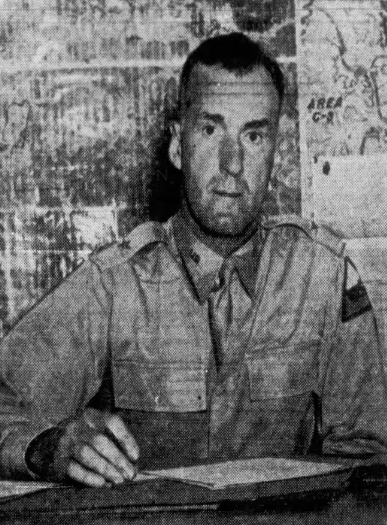 At
the time of the landing in Ireland he was the commander of the
US Army 11th Armored Division.
At
the time of the landing in Ireland he was the commander of the
US Army 11th Armored Division.
The following was published in the The Punxsutawney Spirit on
December 15th 1944.
Leaves From a Correspondent's Note
Book
By THOBURN WIANT
A. P. War Correspondent
WITH THE U. S. SEVENTH ARMY IN ALSACE, Dec. 9 .-
(Delayed)-The eight dirty and unshaven American GI's working
on a muddy road a few hundred yards from German positions
did not know what to ex-pect when a jeep bearing a two-star
plate pulled up beside them.
A six foot, 175 pound man crowled out, returned salutes and
told the GI's to gather around.
"I just want to tell you I think your job is as important as
the job being done by the men with guns," he said.
Whereupon, 51-year-old Major Gen. Edward H. Brooks, of
Concord, N. H., who succeeded Lt. Gen. Lucian K. Truscott,
Jr., new commander of the U. S.
Fifth Army in Italy, as the Sixth Army Corps commander,
crawled back into his jeep and drove off to another part of
the front.
That is typical of Brooks. That's one reason why men like to
take orders from him.
Before any of his divisions attack, Brooks, who commanded
forces spearheading the Allied breakout from the Normandy
beachhead west of St. Lo July 26, spends hours at the
division command post working out plans with his men. Frequently, he'll go up to a
battalion command post to say a few words of encouragement.
Though a serious New Englander, Brooks is not a
spit-and-polish general, but he demands and receives
exactness and efficiency.
The new commander's day begins at 6:30 a. m. and ends at 11
p. m. He lives in a large trailer complete with comfortable
bed, desk, chairs, washing facilities and stove. Paper work
keeps him busy but he likes to get into the field.
With little time for diversion, Brooks occasionally plays
chess with his aides, Capts. William Hershey, of Hartford,
Conn., and Walter T. Wilson, of Birmingham, Ala., or sees a
movie. He writes daily to his wife, Beatrice, and regularly
to his mother, Mrs. Mary F. Brooks, also of Concord; his
son, Lt. Edward H. Brooks, Jr., a West Pointer who commands
a bombardment squadron, and his daughter, Betty, wife of
Major R. P. Campbell.
Brooks was born in New Hampshire and completed his schooling
at Norwich University. He played football, baseball and
hockey. In World War I, he won the Distinguished Service
Cross for an artillery record.
Before Pearl Harbor, Brooks left the War Department's
general staff to join the armored force for which he
developed the self-propelled 105 mm howitzer and an assault
gun. He commanded the 11th Armored Division from August,
1942, until March, 1944, when he took over the Second
Armored Division.
Brooks won the Silver Star for the assistance the Second
Armored supplied in blocking German attempts to split the U.
S. First and Third Armies at their narrowest junction point
in the Percy and Vire areas.
The Cluster was added to that decoration for deploying ten
officers and men, including his two aides, at a crossroads
near Marchiennes to delay by small-arms
fire an SS column of more than 100 vehicles and several
hundred men. The delay made possible the annihilation of the
column by hastily summoned tanks.
The General also holds the Legion of Merit award and an oak
leaf cluster.
His son, named after him, Edward H Brooks Jr, served as a
wartime B-17 pilot but was killed in a crash at St Trond,
Belgium in September 1945. Major General Brooks was at
that time serving as commander of Fourth Service Command based
in Atlanta, Georgia.
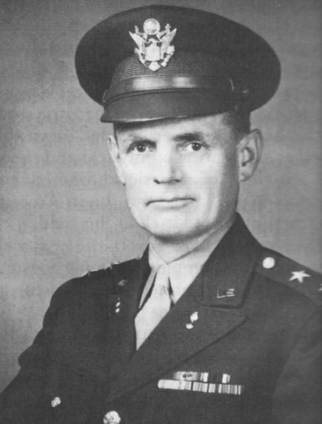 Brig/Gen
Gladeon Marcus BARNES O-2970
Brig/Gen
Gladeon Marcus BARNES O-2970
Brig/Gen Williston Birkhimer PALMER O-12246
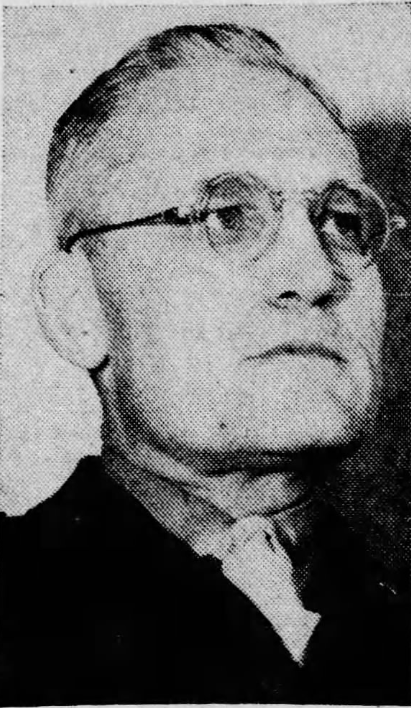
Col William Thaddeus SEXTON O-15777
Maj Earle Lynn HORMELL O-22368
The Knoxville Journal, Wed, May 12, 1943
Col. E. L. Hormell, personal pilot of Lt Gen Jacob Devers, new commander of European operations and who accompanied him to London recently, is a former Knoxvillian and a graduate of the University of Tennessee, it was learned last night through Mrs Barkley, of Black Oak Ridge.
The aide and pilot of General Devers was a member of the class of 1937 at U-T where he was graduated in engineering. After graduation he applied as an aviation cadet and received his wings at Kelly Field Texas in 1939.
He is a son of Mr and Mrs Earl Hormell, formerly of 2209 North Broadway, who now reside on a farm near Liberty, Ind. The father was associated with an automobile firm here before leaving in 1937.
Colonel Hormell and Frances McClain, daughter of Robert McClain, former superintendent of the Southern Railway here now stationed in Washington, were married at Washington in 1940. They have one daughter, Lynn Dixon, aged two.
Lt Gen Devers was appointed commander of European operations following the death of Lt Gen Frank Andrews who was killed in an airplane crash in Ireland*. He arrived In London accompanied by Colonel Hormell last Sunday night.
*Note: General Andrew died in a crash in Iceland on the
3rd of May 1943.
Compiled by Dennis Burke in 2025, with the kind help of the
families of the crew of B-17 41-9045.
